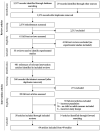Effective and resource-efficient strategies for recruiting families in physical activity, sedentary behavior, nutrition, and obesity prevention research: A systematic review with expert opinion
- PMID: 33331106
- PMCID: PMC7613433
- DOI: 10.1111/obr.13161
Effective and resource-efficient strategies for recruiting families in physical activity, sedentary behavior, nutrition, and obesity prevention research: A systematic review with expert opinion
Abstract
We systematically identified effective and resource-efficient strategies for recruiting families into health promoting intervention research. Four databases were searched for reviews. Interventions were extracted from included reviews. Additionally, a Delphi study was conducted with 35 experts in family-based research. We assessed extracted data from our review and Delphi participants' opinions by collating responses into overarching themes based on recruitment setting then recruitment strategies to identify effective and resource-efficient strategies for recruiting families into intervention research. A total of 64 articles (n = 49 studies) were included. Data regarding recruitment duration (33%), target sample size (32%), reach (18%), expressions of interest (33%), and enrollment rate (22%) were scarcely reported. Recruitment settings (84%) and strategies (73%) used were available for most studies. However, the details were vague, particularly regarding who was responsible for recruitment or how recruitment strategies were implemented. The Delphi showed recruitment settings, and strategies fell under six themes: school-based, print/electronic media, community settings-based, primary care-based, employer-based, and referral-based strategies. Underrecruitment in family-based trials is a major issue. Reporting on recruitment can be improved by better adherence to existing guidelines. Our findings suggest a multifaceted recruitment approach targeting adults and children with multiple exposures to study information.
Keywords: Delphi study; healthy eating; physical activity; screen time.
© 2020 The Authors. Obesity Reviews published by John Wiley & Sons Ltd on behalf of World Obesity Federation.
Conflict of interest statement
The authors declare that they have no conflicts of interest. The views expressed are those of the author(s) and not necessarily those of the National Health Service, the National Institute for Health Research, or the Department of Health and Social Care.
Similar articles
-
An online family-based self-monitoring and goal-setting intervention to improve children’s physical activity: the FRESH feasibility trial and three-arm pilot RCT.Southampton (UK): NIHR Journals Library; 2021 Sep. Southampton (UK): NIHR Journals Library; 2021 Sep. PMID: 34591436 Free Books & Documents. Review.
-
Folic acid supplementation and malaria susceptibility and severity among people taking antifolate antimalarial drugs in endemic areas.Cochrane Database Syst Rev. 2022 Feb 1;2(2022):CD014217. doi: 10.1002/14651858.CD014217. Cochrane Database Syst Rev. 2022. PMID: 36321557 Free PMC article.
-
The most optimal school recruitment strategies for school-based obesity prevention and health promotion research in the United States: A systematic review with Delphi study.Obes Rev. 2024 Nov;25(11):e13808. doi: 10.1111/obr.13808. Epub 2024 Jul 20. Obes Rev. 2024. PMID: 39032149
-
Strategies to improve the implementation of workplace-based policies or practices targeting tobacco, alcohol, diet, physical activity and obesity.Cochrane Database Syst Rev. 2018 Nov 14;11(11):CD012439. doi: 10.1002/14651858.CD012439.pub2. Cochrane Database Syst Rev. 2018. PMID: 30480770 Free PMC article.
-
Beyond the black stump: rapid reviews of health research issues affecting regional, rural and remote Australia.Med J Aust. 2020 Dec;213 Suppl 11:S3-S32.e1. doi: 10.5694/mja2.50881. Med J Aust. 2020. PMID: 33314144
Cited by
-
Self-Reported Eating Speed Is Associated with Indicators of Obesity in Adults: A Systematic Review and Meta-Analysis.Healthcare (Basel). 2021 Nov 16;9(11):1559. doi: 10.3390/healthcare9111559. Healthcare (Basel). 2021. PMID: 34828605 Free PMC article. Review.
-
Sustaining Healthy Habits: The Enduring Impact of Combined School-Family Interventions on Consuming Sugar-Sweetened Beverages among Pilot Chinese Schoolchildren.Nutrients. 2024 Mar 26;16(7):953. doi: 10.3390/nu16070953. Nutrients. 2024. PMID: 38612987 Free PMC article. Clinical Trial.
-
Population Recruitment Strategies in the Age of Bots: Insights from the What Is on Your Plate Study.Curr Dev Nutr. 2025 Apr 15;9(5):107442. doi: 10.1016/j.cdnut.2025.107442. eCollection 2025 May. Curr Dev Nutr. 2025. PMID: 40487551 Free PMC article.
-
Strategies to improve recruitment to multicomponent group programs for overweight and obesity: a systematic review.Front Health Serv. 2025 May 29;5:1404181. doi: 10.3389/frhs.2025.1404181. eCollection 2025. Front Health Serv. 2025. PMID: 40510446 Free PMC article.
-
School-Based Physical Activity Intervention: A Qualitative Process Evaluation of a Feasibility Trial in Yangzhou, China.Int J Environ Res Public Health. 2022 Jan 17;19(2):1021. doi: 10.3390/ijerph19021021. Int J Environ Res Public Health. 2022. PMID: 35055842 Free PMC article. Clinical Trial.
References
-
- Abarca-Gómez L, Abdeen ZA, Hamid ZA, et al. Worldwide trends in body-mass index, underweight, overweight, and obesity from 1975 to 2016: A pooled analysis of 2416 population-based measurement studies in 128.9 million children, adolescents, and adults. The Lancet. 2017;390(10113):2627–2642. - PMC - PubMed
-
- Hallal PC, Andersen LB, Bull FC, et al. Global physical activity levels: surveillance progress, pitfalls, and prospects. The Lancet. 2012;380(9838):247–257. - PubMed
-
- Aubert S, Barnes JD, Abdeta C, et al. Global matrix 3.0 physical activity report card grades for children and youth: Results and analysis from 49 countries. Journal of Physical Activity and Health. 2018;15(S2):S251–S273. - PubMed
Publication types
MeSH terms
Grants and funding
LinkOut - more resources
Full Text Sources
Medical


